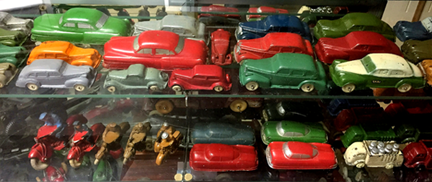By Dave Leopard

The Auburn Rubber Company, based in Auburn, Indiana, was originally the Double Fabric Tire Company, which was established in 1910 by Auburn residents William H. Willennar and A.L. Murray. As the Double Fabric Tire Company, they made inner soles and tire patches before expanding into a line of automobile tires and tubes. The company’s success led to expansion to a new site in 1912, but they were devastated by a fire in 1913 that destroyed the entire block surrounding their new building. They lost just about everything. Everything, that is, but their determination. Thanks to good insurance, Willennar and Murray were able to rebuild and quickly return to production. In the 1920s, the company reorganized as the Auburn Rubber Company. As the Auburn Rubber Company grew, its reputation grew as well and it was soon considered one of the most financially secure companies in the United States.
The Auburn Rubber Company naturally progressed to the business of making toys. It became known for producing toy soldiers, tractors, animals, games and sporting equipment. It released its first rubber toy car in 1936. It was a six-inch red Cord sedan.
As World War II approached and restrictions were put in place regarding the use of steel, iron, and rubber, leisure manufacturing was all but eliminated. The Auburn Rubber Company was determined to keep toys in the hands of children around the country and decided to use new materials (those not strategic to war) and made do during wartime with toys made of composition. The first really decent plastic toy was released by the Kilgore Company in 1937.
The main two producers of plastics then became Auburn and the Sun Rubber Company, Auburn located in Pennsylvania, and Sun in Ohio. Both states were centrally located to industry and therefore able to capitalize on the market at the time.
The Auburn Rubber Company was hugely successful in whatever it endeavored. When World War II ended, the company was free to use a variety of materials again and found that there was a great need for industrial parts (steel, iron, and rubber). The new president of Auburn, Dave Sellew, became an international presence in the manufacturing world and his products were considered to be of high quality as well as increasingly current to the changing times. Overwhelmed by the demand for toys, Auburn actually opened a plant in Connellsville, Pennsylvania, dedicated to toy production. In fact, during the late 1940s, all Auburn toys were produced in Pennsylvania. The last rubber toys Auburn made (racers and firetrucks) were released in 1953. From 1954 on, its toys were made of vinyl.
In 1960, Auburn made an interesting move and sold its toy products division to the city of Deming, New Mexico. There, toy production continued but was not sustainable, and in 1969 the company filed for bankruptcy.
Compared with other toy car manufacturers, Auburn released toy cars more closely resembling actual and current model automobiles. Its cars were bigger than those produced by the Sun Rubber Company of Ohio and reflected greater detail. They also cost more than Sun Rubber’s toys. Now, it could be argued that the best designs and highest quality products were actually produced by a company called Rainbow Rubber Company out of Butler, Pennsylvania (my personal favorite toy car is Rainbow’s 1938 blue Oldsmobile).
Auburn excelled because it had a great management team whose ideas were innovative and because of its great reputation and highly effective marketing strategies, including the regular release of catalogs to advertise featured products. It was ahead of its time and kept up with the times, leaving magnificent treasures on wheels to be enjoyed by all generations.
Source:Rubber Toy Vehicles: Identification & Value Guide Paperback – April, 2003 by Dave Leopard. Schiffer Publisher.
